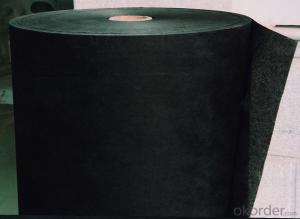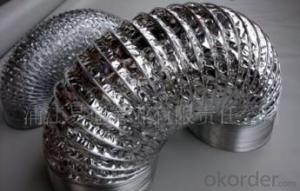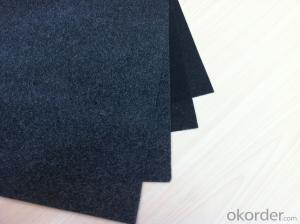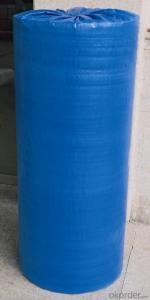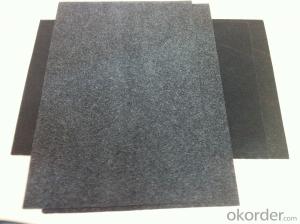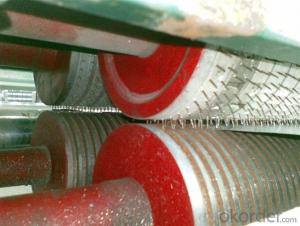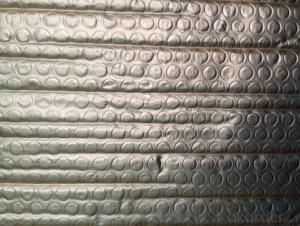Fiberglass Facing Reinforcement Tissue for Roofing Acoustic-65C
- Loading Port:
- Shanghai
- Payment Terms:
- TT OR LC
- Min Order Qty:
- 500 m²
- Supply Capability:
- 100000 m²/month
OKorder Service Pledge
OKorder Financial Service
You Might Also Like
Specification
Introduction of Fiberglass Tissue
Fiberglass Tissue is a kind of facing, which is made of by the white fiberglass tissue, and special production process.
Application of Fiberglass Tissue
Our black tissue are mainly used as facing for glass wool insulation, rockwool, mineral wool etc. Also fiberglass tissue facing is used under roof decking, under attic rafters, over existing attic thermal insulation, in floors, walls and crawl spaces, and in industrial and commercial buildings to block radiant heat coming into house through the roof during the summer and retain indoor heat generated during in winter
Advantage of Fiberglass Tissue
Light weight
• High manufacturing accuracy
• High strength
• Small inertia resistance
• Strong heat dissipation ability
• Good visual effect
• High reflective insulation
• Heat resistant, water proof, stable at high temperature;
• Environmentally friendly, no smell and not-toxic;
• Smooth and clear surface;
Packing of Fiberglass Tissue
1. Waterproof paper then PVC shrinking Film
2. Water-Proof film only
3. Woven cloth
4. Kraft paper or Water Proof Film then Metal/wooden pallet
5. (Also as your request. )
Pictures of Fiberglass Tissue
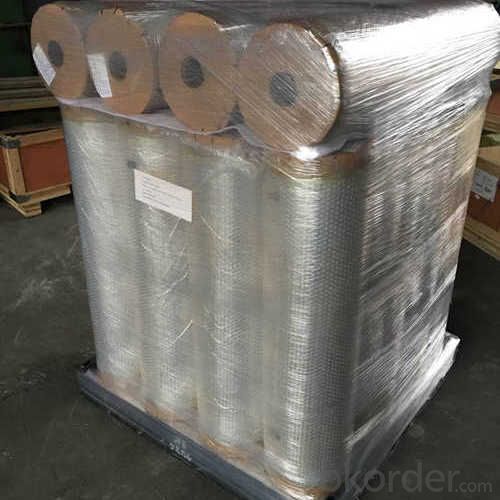


Specification of Fiberglass Tissue
Specification | ||
ITEM | UNIT | VALUE |
Type | C | |
Weight | g/m2 | 65±5 |
Thickness | mm | 0.40 |
Tensile Strength MD | n/125px | ≥130 |
Tensile Strength XD | n/125px | ≥90 |
Fiber Diameter | µ | 9 |
Fire Resistant Property | B1 | |
FAQ
We have organized several common questions for our clients,may help you sincerely:
1. What is the storage condition?
The Aluminum Foil Facing should be stored at room temperature and kept from wet and heat source.
2. How to guarantee the quality of the products?
We have established the international advanced quality management system,every link from raw material to final product we have strict quality test;We resolutely put an end to unqualified products flowing into the market. At the same time, we will provide necessary follow-up service assurance.
3. How long can we receive the product after purchase?
In the purchase of product within four working days, we will arrange the factory delivery as soon as possible. The specific time of receiving is related to the state and position of customers. Commonly 7 to 10 working days can be served.
- Q: Does fiberglass facing require regular maintenance?
- No, fiberglass facing does not require regular maintenance. Fiberglass is a durable material that is resistant to many environmental factors, such as moisture, UV rays, and pests. It does not rust, rot, or decay like other materials, which means it does not need to be painted or sealed regularly. However, it is important to keep the fiberglass facing clean and free from dirt or debris to maintain its appearance and performance. Regular cleaning with a mild detergent and water should be sufficient to keep it in good condition. Additionally, if any damage or cracks occur in the fiberglass facing, it should be repaired promptly to prevent further issues. Overall, fiberglass facing is a low-maintenance option that can last for many years with minimal care.
- Q: This question asks for a comparison of the benefits and drawbacks of utilizing black fiberglass tissue in construction projects.
- <p>Black fiberglass tissue offers several advantages in construction, such as high strength, resistance to corrosion, and durability. It is lightweight and can withstand harsh weather conditions, making it suitable for various applications. Additionally, it has excellent insulation properties, which can help in reducing energy consumption. However, it also has some disadvantages. The primary one is its cost; black fiberglass tissue can be more expensive than traditional materials. It also requires specialized knowledge and equipment for installation, which can increase labor costs. Furthermore, while it is resistant to many elements, it may not perform as well in high-temperature environments, and its disposal can be challenging due to environmental concerns.</p>
- Q: What are the potential hazards and precautions one should be aware of when handling black fiberglass tissue?
- <p>Black fiberglass tissue can pose safety concerns due to its fibrous nature and potential to cause skin irritation, respiratory issues, and eye injuries. To mitigate these risks, it's crucial to wear appropriate personal protective equipment (PPE), including gloves, safety glasses, and a respirator mask. Avoid inhaling dust or fibers, and ensure proper ventilation in the work area. Skin contact should be minimized, and any contact should be followed by thorough washing with soap and water. Dispose of the material according to local regulations to prevent environmental contamination.</p>
- Q: What is the tensile strength of black fiberglass tissue?
- <p>The tensile strength of black fiberglass tissue can vary depending on the specific type and manufacturing process. Generally, it ranges from 500 to 3000 MPa (or 72,500 to 435,000 psi). This high tensile strength makes it suitable for applications requiring high strength-to-weight ratios, such as in construction, automotive, and aerospace industries. It's important to note that the exact tensile strength should be obtained from the manufacturer's specifications for the specific product in question.</p>
- Q: Can previously used black fiberglass tissues be repurposed for other uses?
- <p>Yes, you can potentially reuse your old black fiberglass tissues for various purposes. Fiberglass is durable and can be repurposed in projects such as reinforcing materials in DIY crafts, insulation, or even as a component in certain types of artwork or sculptures. However, it's important to assess the condition of the fiberglass to ensure it's still safe and effective for reuse. Always handle with care, as fiberglass can cause skin and respiratory irritation. If it's damaged or contaminated, it may not be suitable for reuse.</p>
- Q: This question asks about the application of glass fiber paper in construction projects, seeking to understand its role and how it is utilized.
- <p>Glass fiber paper is used in construction projects for various purposes due to its high strength, durability, and resistance to heat and moisture. It is often used as a reinforcing material in concrete, providing additional strength and preventing cracks. It can also be used as a barrier to prevent water and moisture from penetrating walls and ceilings, acting as a vapor barrier. In insulation applications, it helps to reduce heat transfer and improve energy efficiency. Glass fiber paper is also used in the production of fiberglass, which is used for roofing, insulation, and other structural components. It's important to follow safety guidelines when handling glass fiber paper due to its potential health risks.</p>
- Q: This question asks for a comparison between black fiberglass tissue and cotton tissues regarding their performance and cost-effectiveness.
- <p>Black fiberglass tissue and cotton tissues have distinct differences in performance and cost. Black fiberglass tissue, known for its strength and durability, is often used in industrial applications where heat resistance and chemical resistance are required. It is non-absorbent and does not rot, making it suitable for outdoor and harsh environments. However, it is generally more expensive than cotton due to its specialized manufacturing process. Cotton tissues, on the other hand, are soft, absorbent, and biodegradable, making them ideal for personal care and domestic use. They are more cost-effective and widely available but lack the durability and heat resistance of fiberglass tissues. Overall, the choice between black fiberglass and cotton tissues depends on the specific application and budget considerations.</p>
- Q: This question asks about the distinctions among various types of glass fiber paper, which are materials made from thin strands of glass.
- <p>Different types of glass fiber paper are distinguished by their composition, manufacturing processes, and applications. E-glass is the most common and is used for general purposes due to its good electrical insulation properties. S-glass, known for its high strength, is used in applications requiring mechanical strength, such as in aircraft and sports equipment. C-glass is resistant to chemical corrosion and is used in environments with harsh chemicals. A-glass, or alumino-borosilicate glass, is used for applications requiring high temperature resistance. Lastly, D-glass is designed for low dielectric applications, making it suitable for electronics. Each type has unique properties that make it suitable for specific industries and applications.</p>
- Q: Is it possible to utilize black fiberglass tissue as an insulating material in construction?
- <p>Yes, black fiberglass tissue can be used for building insulation. It is a type of insulation material known for its thermal and acoustic insulation properties. Black fiberglass is made from glass fibers and is often used in construction for insulating walls, roofs, and floors. It helps to reduce heat transfer, thereby improving energy efficiency and comfort within the building. However, it's important to note that proper installation and safety precautions are necessary due to the potential health risks associated with fiberglass, such as skin and respiratory irritation.</p>
- Q: Is it possible to recycle glass fiber paper once it has been used?
- <p>Yes, glass fiber paper can be recycled after use. The recycling process typically involves shredding the paper to separate the glass fibers from other materials. These fibers can then be used to create new products such as insulation, reinforcing materials for composites, or even as a component in new paper products. However, the recycling process for glass fiber paper may vary depending on the specific composition and the presence of any contaminants, which can affect its recyclability. It's important to check with local recycling facilities to understand their specific guidelines and capabilities for recycling glass fiber paper.</p>
Send your message to us
Fiberglass Facing Reinforcement Tissue for Roofing Acoustic-65C
- Loading Port:
- Shanghai
- Payment Terms:
- TT OR LC
- Min Order Qty:
- 500 m²
- Supply Capability:
- 100000 m²/month
OKorder Service Pledge
OKorder Financial Service
Similar products
Hot products
Hot Searches
Related keywords

